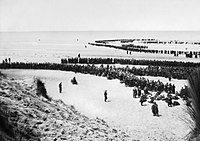
Photo from wikipedia
The critical role of evacuation, particularly for the communities in developing countries exposed to cyclones, has only been realized after some disastrous evacuation experiences in recent cyclones. A profound understanding… Click to show full abstract
The critical role of evacuation, particularly for the communities in developing countries exposed to cyclones, has only been realized after some disastrous evacuation experiences in recent cyclones. A profound understanding of the factors influencing the evacuation behavior is necessary to reduce the loss of lives, especially in the cyclone prone communities. The purpose of this research is to identify the key factors influencing households' evacuation decision during a cyclone in developing economies. To this end, the research employs state of the art discrete choice modeling techniques referred to as mixed logit models. The study builds on the data collected in 1991 from the coastal areas of Bangladesh following the cyclone Sidr. The analysis result reveals that the evacuees of developing countries like Bangladesh resort to nearby tall buildings during cyclone due to the insufficient facilities provided by the cyclone centers. In case of mandatory evacuation and for temporary house owner, the households' decision to evacuate is found to be uniform. However, significant heterogeneity is found in the households' decision to evacuate whenever they receive a voluntary notice and also if they live sufficiently far from the sea shore. The factors that are identified to be influencing households' evacuation decision during a cyclone will enable potential evacuees to better evaluate their decision and consequently make more informed decision about the timing as well as the necessity of evacuation. The analysis result will also help emergency managers to decide on the timing and the type of evacuation orders they need to provide for reducing causalities due to landfall caused by cyclones.
Journal Title: Journal of emergency management
Year Published: 2019
Link to full text (if available)
Share on Social Media: Sign Up to like & get
recommendations!